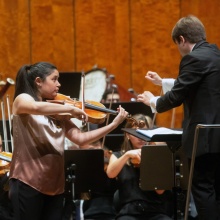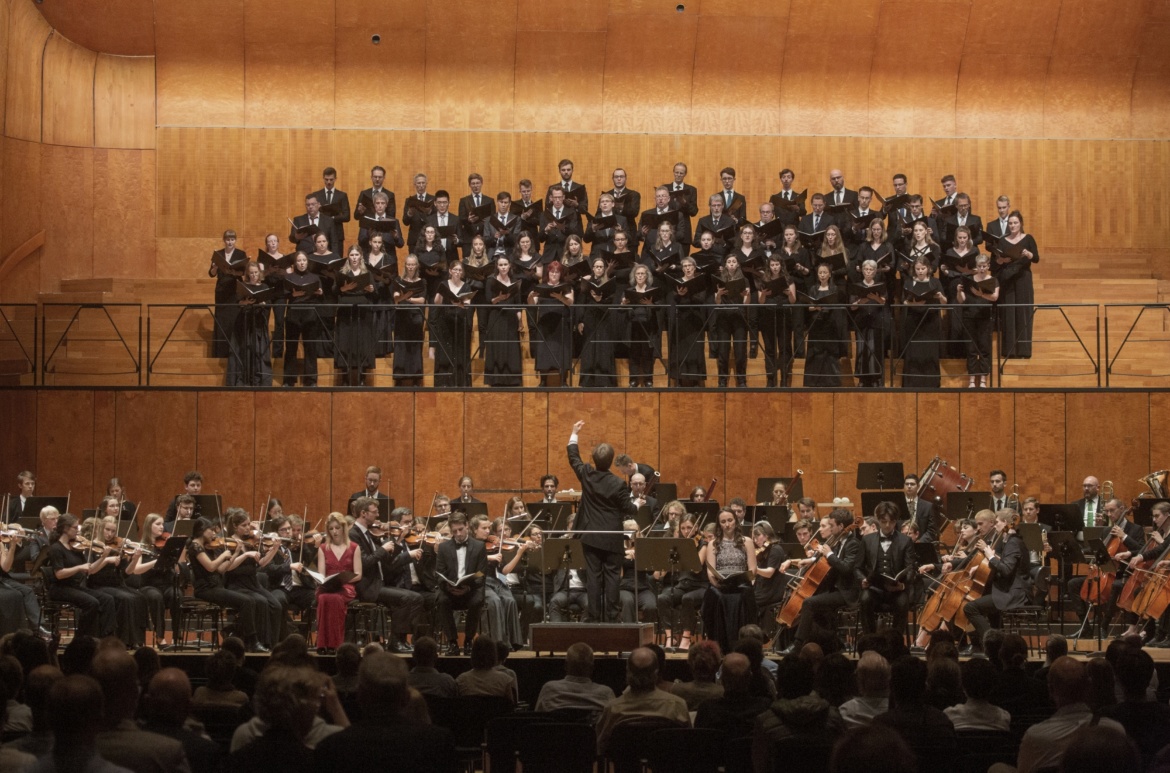With the big stage in the Liederhalle in Stuttgart, the Academic Choir and the Academic Orchestra conducted by Mihály Zeke, the music director of the University, and a program that featured many discoveries worth listening to – both the musicians and the audience went into the Beethoven Hall with a great deal of anticipation. In the course of the concert, the musicians repeatedly showed their great joy in playing with each other and in the music itself. The evening’s music brought together composers Johannes Brahms and Robert Schumann and Béla Bartók and Zoltán Kodály.
Brahms and Schumann
The concert opened with the “Tragic Overture” by Johannes Brahms. Brahms apparently did not have a specific tragedy in mind as a subject because he was writing an Academic Festival Overture at the same time in gratitude for the honorary doctorate from the University of Breslau. Thus, despite the harsh and gloomy tones, pure optimism sounds through time and again. From cheerful to melancholy – the orchestra took the audience into the varied and spirited emotional world of Brahms, whom Robert Schumann proclaimed would be the one to carry the torch of Beethoven.
The program continued with Schumann’s Symphony No. 4 in D minor, which was full of contrasts. The energetic trombones, rapturous violins, and a romance between the oboe and violoncello were quite mysterious at times. Right up until the jubilant, euphoric conclusion, the symphony took the audience on an enchanting musical voyage of discovery and made it quite understandable why Schumann’s wife Clara had described the Fourth Symphony as “a work from the depth of the soul”.
Bartók & Kodály
The musical companions Béla Bartók and Zoltán Kodály were united by a friendship as well as a love of Hungarian folk music. Kodály was convinced that only on the basis of the folk song would he be able to find his own Hungarian musical language. Bartók had written the Concerto for Viola and Orchestra at the request of viola virtuoso William Primrose, who wanted a concerto for viola and suggested that the composer should “in no way feel constrained by the apparent limitations of the instrument”. The work was completed only after Bartók’s death by his apprentice, Tibor Serly. Together with the Academic Orchestra, the Chilean violist Paulina Riquelme conveyed Bartók’s musical style in a particularly impressive way right up to the brilliant ending.
The Academic Choir and the Academic Orchestra, together with soloists Hannah Gries (soprano), Jasmin Hofmann (alto), Philipp Nicklaus (tenor), and Junoh Lee (bass), brought the evening to a successful close with the “Budavári Te Deum” by Zoltán Kodály. The impressive praise of God, written by Kodály on the occasion of the 250th anniversary of the liberation of Buda from Turkish rule, combines sacred European music with a Hungarian musical style. The Latin text goes back to the “Ambrosian Hymn of Praise” from the 4th century. The audience enjoyed an extremely exciting listening experience with timpani and trumpets.
The companions were well received by the audience. The journey of discovery through musical works – some of which are seldom heard – which were performed with skill and enthusiasm by the musicians, was met with thunderous applause from the concert attendees.



